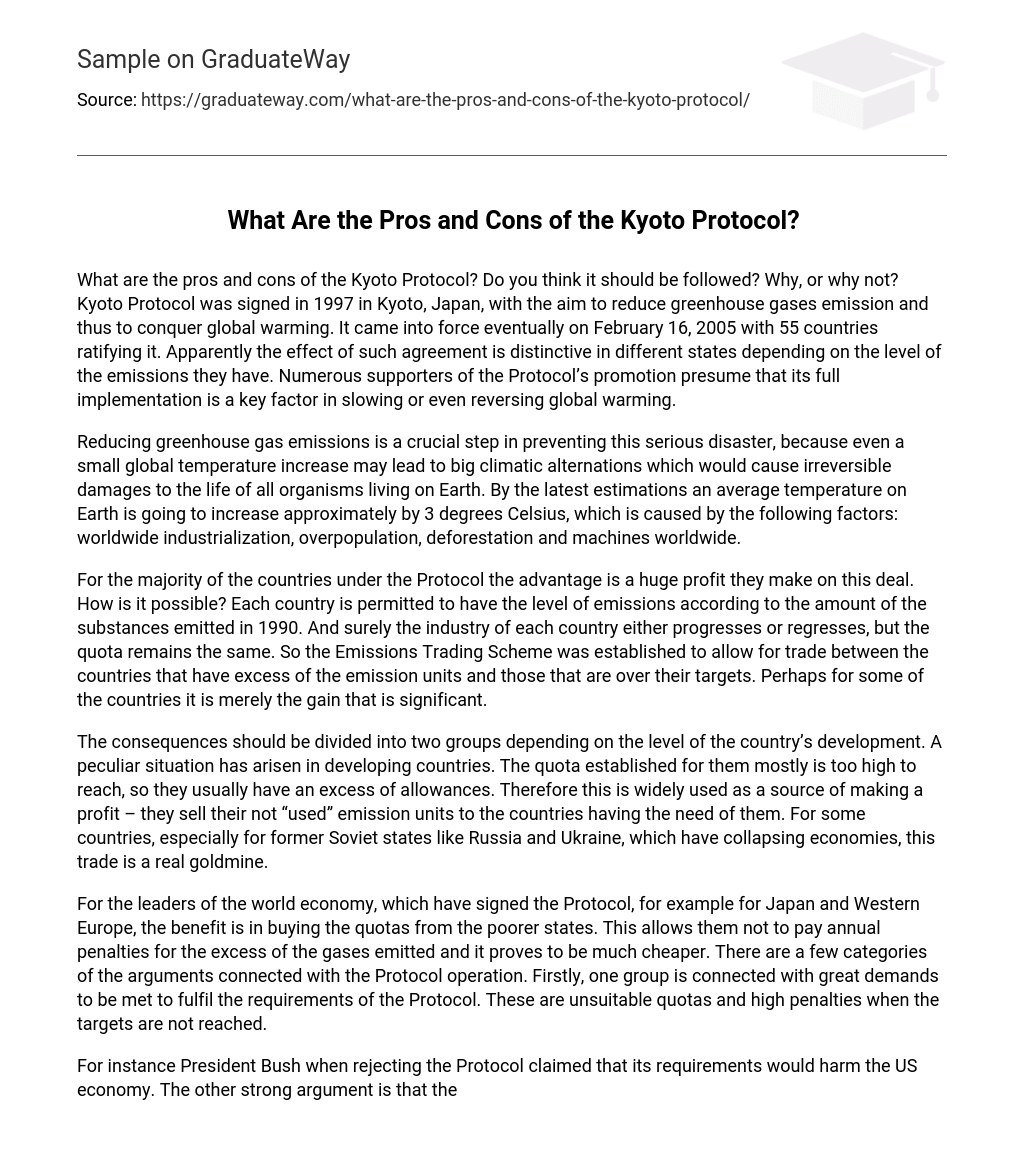What are the pros and cons of the Kyoto Protocol? Do you think it should be followed? Why, or why not? Kyoto Protocol was signed in 1997 in Kyoto, Japan, with the aim to reduce greenhouse gases emission and thus to conquer global warming. It came into force eventually on February 16, 2005 with 55 countries ratifying it. Apparently the effect of such agreement is distinctive in different states depending on the level of the emissions they have. Numerous supporters of the Protocol’s promotion presume that its full implementation is a key factor in slowing or even reversing global warming.
Reducing greenhouse gas emissions is a crucial step in preventing this serious disaster, because even a small global temperature increase may lead to big climatic alternations which would cause irreversible damages to the life of all organisms living on Earth. By the latest estimations an average temperature on Earth is going to increase approximately by 3 degrees Celsius, which is caused by the following factors: worldwide industrialization, overpopulation, deforestation and machines worldwide.
For the majority of the countries under the Protocol the advantage is a huge profit they make on this deal. How is it possible? Each country is permitted to have the level of emissions according to the amount of the substances emitted in 1990. And surely the industry of each country either progresses or regresses, but the quota remains the same. So the Emissions Trading Scheme was established to allow for trade between the countries that have excess of the emission units and those that are over their targets. Perhaps for some of the countries it is merely the gain that is significant.
The consequences should be divided into two groups depending on the level of the country’s development. A peculiar situation has arisen in developing countries. The quota established for them mostly is too high to reach, so they usually have an excess of allowances. Therefore this is widely used as a source of making a profit – they sell their not “used” emission units to the countries having the need of them. For some countries, especially for former Soviet states like Russia and Ukraine, which have collapsing economies, this trade is a real goldmine.
For the leaders of the world economy, which have signed the Protocol, for example for Japan and Western Europe, the benefit is in buying the quotas from the poorer states. This allows them not to pay annual penalties for the excess of the gases emitted and it proves to be much cheaper. There are a few categories of the arguments connected with the Protocol operation. Firstly, one group is connected with great demands to be met to fulfil the requirements of the Protocol. These are unsuitable quotas and high penalties when the targets are not reached.
For instance President Bush when rejecting the Protocol claimed that its requirements would harm the US economy. The other strong argument is that the achievement under the Protocol is not too high in comparison with the efforts involved. The opponents say the Protocol isn’t efficient enough to reduce greenhouse gases and so to reach its initial aim. Some scientists are skeptical even of the main underlying reason of the treaty – the global warming itself as a result of human industrial activity.
Finally, some critics assert that the treaty focuses on greenhouse gases without taking into account the population growth and other aspects that may affect global warming. The year 2012 is the end of the first commitment period of the Kyoto Protocol, so the actual results and decisions will be under discussion. The overall emissions were cut by about 3% from 1990 to 2000, but mostly it is reached because of a significant emissions decrease from the collapsing economies of former Soviet countries.
In fact, the level of emissions hasn’t considerably reduced. The conclusion can be drawn from the above mentioned that the emissions weren’t cut intentionally, but this reduction is a result of a flagging economy. So, Kyoto should be viewed only as a stepping stone to more intensive activity. The other essential drawback is that it is senseless without the major economic leaders, such as USA and Canada. Only immediate multinational collaboration can be helpful, but not the vain attempts of some countries.
Finally, the last argument against the Protocol is that it brings not reducing of the gases emissions but redistribution of them between different countries – when the quota isn’t reached by one state it is sold to the other, so the level remains the same. To summarize, the Kyoto Protocol has some advantages, but the there are much more weak points, so it would rather be alternated to eliminate them or not be followed.
Sources:
BBC NEWS/Science-Nature/Q&A: The Kyoto Protocol United Nations Framework Convention on Climate Change/Kyoto Protocol/Mechanisms





